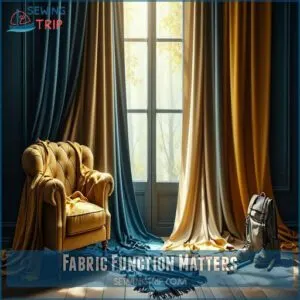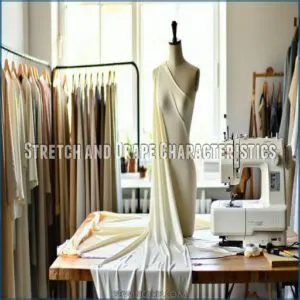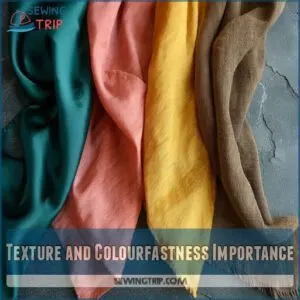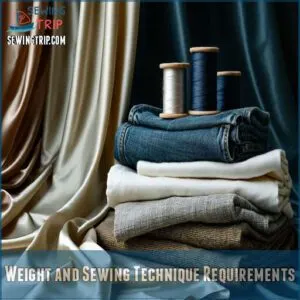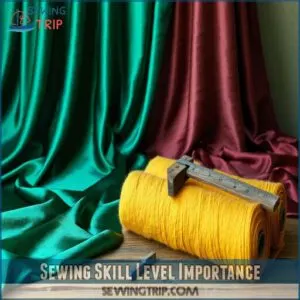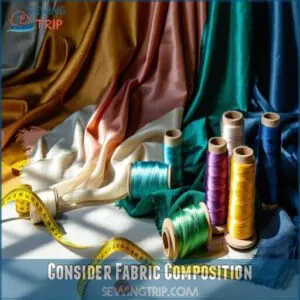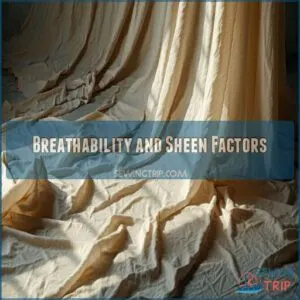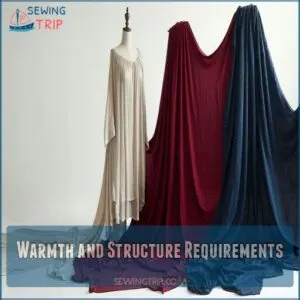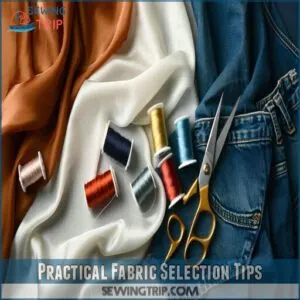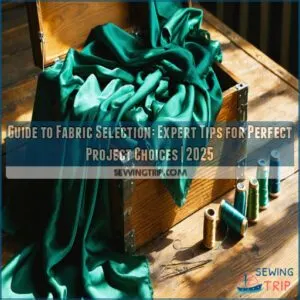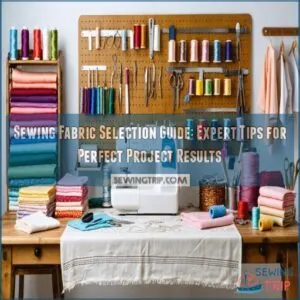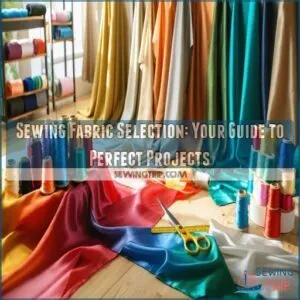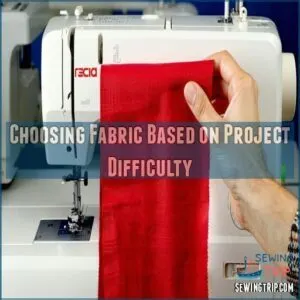This site is supported by our readers. We may earn a commission, at no cost to you, if you purchase through links.
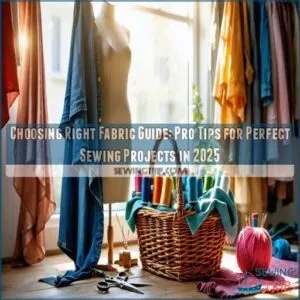
Start by matching the fabric to your project’s purpose – you wouldn’t use silk for outdoor gear.
Consider the fabric’s weight, durability, and care requirements.
Lightweight fabrics need delicate handling, while heavy ones demand stronger tools.
Your skill level matters too – beginners should stick to stable, medium-weight fabrics.
Think about where you’ll wear it and how much maintenance you’re willing to do.
The perfect fabric balances function, durability, and your budget.
Once you understand these basics, you’ll discover how fabric properties can transform your next creation.
Table Of Contents
Key Takeaways
- You’ll need to match the fabric’s function to your project – consider weather conditions, activity level, and how often you’ll wear the garment to ensure it meets your practical needs.
- Your sewing skill level should guide your fabric choice – start with stable cotton if you’re a beginner, then progress to more challenging materials like silk or chiffon as your expertise grows.
- You can’t skip testing fabric properties – examine the stretch, drape, texture, and colorfastness to guarantee your material will behave as needed during construction and wear.
- You’ll want to factor in maintenance requirements – check care labels, understand cleaning methods, and consider how much time you’re willing to spend on upkeep before making your final selection.
Fabric Function Matters
You’re choosing a fabric for your sewing project, and it’s important to evaluate how you’ll use the garment.
You need to evaluate the weather, your activities, and how often you’ll wear it to choose the right fabric.
Weather and Activity Considerations
When sewing outdoor gear, consider climate control and weather resistance.
Your activity level and the project’s purpose dictate fabric choice.
For seasonal wear, think about the weather, opting for breathable fabrics in warm climates and insulating ones in cold climates, ensuring your outdoor gear is suitable.
For Valentine’s Day sewing, explore these festive project ideas, which can help with weather resistance in your sewing projects.
Durability and Ease of Cleaning
When choosing fabric, consider durability and ease of cleaning.
Look for stain resistance and fabric longevity. Think about cleaning methods and wear testing to guarantee low maintenance costs.
This helps you select a fabric that’s easy to care for and lasts longer, saving you time and money.
Considering a fabric with durable easy clean properties can greatly impact the overall quality of your sewing project, ensuring it has a long lifetime.
Budget and Fabric Quantity
You consider fabric costs, budget planning, and quantity calculation.
For small projects, local stores offer affordable options under $50.
Understanding fabric properties and characteristics is essential.
Fabric estimation and cost optimization are key to staying within budget, ensuring you get the right amount of fabric without breaking the bank, using budget planning effectively.
Fabric Properties Explained
You’re choosing a fabric for your sewing project, and it’s necessary to understand its properties.
You need to evaluate factors like stretch, drape, texture, and colourfastness to guarantee the fabric works well for your project.
Stretch and Drape Characteristics
Now that you’ve got function figured out, let’s talk about how your fabric moves and stretches. Understanding fabric stretch and drape analysis helps you pick the perfect material for your project.
A detailed fabric drape and texture guide can be invaluable. You’ll want to test textile movement by hanging different fabrics to see how they fall.
Some materials stretch more than others, especially knit fabrics with elastic properties. To assess this, you can perform a few simple tests:
- Hold the fabric up and let it hang naturally – watch how it flows
- Stretch test: Pull gently in both directions to check elastic properties
- Wrap the material around a dress form to see its draping behavior
- Compare similar weight fabrics side by side for movement differences
- Check the fabric’s recovery by stretching and releasing it several times
Texture and Colourfastness Importance
Beyond a fabric’s stretch, its texture and colourfastness shape your project’s success.
The way light plays on material softness can make or break your design’s appeal.
You’ll want to test dye fixation before cutting – nobody wants a gorgeous creation that fades after washing.
| Texture Type | Nap Direction | Colour Stability |
|---|---|---|
| Smooth | One-way | High |
| Brushed | Reversible | Medium |
| Raised | Multi-way | Variable |
| Textured | None | Permanent |
Weight and Sewing Technique Requirements
The fabric’s density directly impacts your sewing success.
Lightweight materials need smaller needles and delicate thread tension, while heavyweight fabrics demand stronger tools and stabilizer options.
You’ll need specific sewing tools based on fabric weight – walking feet for silk, double needles for jersey.
Don’t forget to match interfacing needs to your fabric’s weight for professional results, considering the overall sewing success.
Sewing Skill Level Importance
You’ll want to match your fabric choice with your current sewing abilities to avoid frustration and wasted materials.
Your skill level helps determine which fabrics work best for you, from sturdy cotton for beginners to slippery silk for experienced sewers.
Beginner-Friendly Fabric Options
Most beginner sewists flourish with cotton blends as their first fabric choice.
You’ll find these materials easy to handle, mark, and cut.
When shopping at fabric stores, look for medium-weight cotton with good fabric softness – it won’t slip around while you’re learning basic sewing tools.
Quilting cotton and muslin are ideal starting points.
They’re forgiving, washable, and perfect for practicing your beginner tips.
For more options, explore these beginner-friendly fabric choices.
Advanced Sewing Fabric Choices
Once you’re comfortable with basic materials, you’ll love exploring complex fabrics. Advanced knits, silks, and chiffons open up exciting possibilities in your sewing journey.
Sourcing advanced sewing fabrics online opens up more options. Here’s what makes textile science fascinating at this level:
- Fabric blending lets you combine durability with luxury
- Specialized sewing tools handle delicate materials with precision
- Professional fabric sourcing delivers top-quality results
These challenging materials reward your growing expertise with stunning finished pieces.
Fabric Content and Stretch Considerations
While mastering complex materials takes practice, understanding fabric blend basics puts you ahead of the game.
Start by checking the fibre ratio on labels – a higher cotton percentage means less stretch.
The yarn thickness and weave density affect how much give you’ll get. Remember, stretch factor varies: knits offer more flexibility than wovens, so pick what matches your project’s movement needs, considering the overall movement needs.
Choosing Right Fabric Type
You’ll need to match your fabric’s properties with your project’s needs, considering factors like breathability, durability, and how the material moves.
The right fabric choice depends on what you’re making, from flowy dresses that need lightweight fabrics to structured jackets that require sturdier materials.
Consider Fabric Composition
Now that you’ve got your sewing skills down, let’s discover the secrets of fabric composition.
Understanding thread count and yarn type helps you match materials to your vision. Check the fiber blend percentages – they’ll tell you how your fabric will behave.
Higher fabric density usually means better quality, while the weave structure affects durability.
You’ll want different compositions for different projects, considering the fiber blend percentages to ensure the best results.
Breathability and Sheen Factors
Explore your fabric’s breathability and sheen before making that final cut.
Natural fibers like cotton and linen offer excellent moisture wicking for comfort during wear.
When examining sheen levels, consider how light reflection affects your garment’s appearance – silk and satin create elegant looks, while matte fabrics like jersey provide subtle sophistication.
Texture analysis helps you balance both practical comfort and visual appeal, ensuring a comfortable wear.
Warmth and Structure Requirements
For maximum warmth, select fabrics based on their thermal insulation properties.
Dense materials like wool offer excellent warmth retention, while structured fabrics maintain garment shape.
You’ll want to evaluate layering options – lightweight cotton beneath and heavier materials on top.
Fabric density affects both heat retention and structure support, so choose materials that match your project’s temperature and stability needs, considering layering options and fabric density.
Practical Fabric Selection Tips
You’ll learn essential tips to spot quality fabrics and handle them properly for your sewing projects.
These practical techniques, from pre-washing fabrics to using the right sewing tools, will help you create professional-looking garments that last.
Identifying Low-Quality Fabrics
Many fabric tests can reveal hidden material defects before you invest in your project.
When examining potential fabrics, trust both your eyes and hands to spot quality issues.
Check weave quality by holding fabric up to light, and assess fiber content through touch and stretch tests.
- Look for loose threads, uneven seams, and visible flaws in fabric density
- Test color bleeding by rubbing a white cloth on darker fabrics
- Gently stretch fabric in multiple directions to evaluate construction integrity
This process helps ensure that you are working with high-quality materials, which is crucial for the success of your project, by identifying potential issues such as color bleeding and loose threads.
Pre-Washing and Shrinking Prevention
Pre-washing fabric is your first defense against unwanted shrinkage.
Different fiber blending affects how materials react to water and heat.
Check yarn tension and weave density before pre-treating – loose weaves need gentler handling.
Natural fibers typically shrink more than synthetics.
To minimize shrinkage, understand proper washing techniques.
Always wash your fabric the same way you’ll clean the finished garment.
Test a small corner if you’re unsure about fabric shrinkage behavior.
Aligning Pattern Pieces With Grainlines
After preparing your fabric, getting the grainline alignment right can make or break your project.
Think of grainlines as your fabric’s compass – they guide proper pattern matching and fabric orientation.
Here’s how to nail it:
- Line up pattern arrows with fabric’s lengthwise grain
- Use a ruler to measure from selvage to pattern edge
- Pin carefully at measured points
- Double-check seam accuracy before cutting
Using Walking Feet for Slippery Fabrics
When you’re up against slippery fabrics, a walking foot becomes your best friend.
This specialized presser foot helps feed both layers of fabric evenly through your sewing machine, preventing shifting and puckering.
For specific sewing machine feet, explore these walking foot options for silk.
| Fabric Type | Walking Foot Benefit | Grip Aid Needed |
|---|---|---|
| Silk | Prevents slipping | Light stabilizer |
| Satin | Reduces puckering | Cotton backing |
| Chiffon | Even feed | Tissue paper |
| Polyester | Smooth stitching | None |
| Rayon | Controls stretch | Spray adhesive |
Simply attach the walking foot to your machine, adjust the pressure, and watch as those tricky fabrics glide smoothly under your needle.
Final Fabric Selection Considerations
You’ll make smarter fabric choices by considering how the material looks and feels, along with how much time you can spend on care and maintenance.
When you’re ready to buy fabric, remember to check the weight, seasonal suitability, and overall quality to make sure your sewing project turns out exactly as you’ve planned, which involves considering complete concepts.
Visual Appeal and Pattern Alignment
While you pondering that bold print fabric, take a moment to ponder how it’ll look in your finished piece.
Your fabric’s print scale should match your project size – tiny florals work beautifully for small items, while larger patterns suit dresses or coats.
Pattern mixing isn’t just for fashion magazines – you can blend different prints by matching their colour schemes and varying their scales.
Maintenance and Care Requirements
While beautiful patterns catch your eye, don’t forget to check those care labels.
Your fabric’s durability depends on proper maintenance. Consider the guide to fabric selection for your project.
Some materials need dry cleaning, while others handle weekly washes like a champ.
Learn basic stain removal techniques for your chosen fabric, and store it correctly to prevent damage.
Smart laundry tips: Test cleaning methods on scraps first, and always follow manufacturer guidelines.
Fabric Weight and Seasonal Appropriateness
Success in fabric selection hinges on matching fabric density to the season.
Light cottons and linens work best for summer projects, while thermal insulation from wool blends suits winter wear.
Consider weight classes when layering fabrics – lightweight materials for inner layers, medium-weight for main garments, and heavyweight for outerwear.
Seasonal fabrics should align with both comfort needs and practical wear requirements.
Making Informed Fabric Purchasing Decisions
Beyond picking seasonal fabrics, you’ll need smart fabric sourcing strategies for your projects.
Check online fabric descriptions carefully to understand textile science basics – like fiber content and care requirements.
When material sustainability matters, compare prices across shops and factor in Sewing Tools you might need.
Remember, fabric budgeting isn’t just about cost – quality fabrics last longer and perform better in the long run.
Frequently Asked Questions (FAQs)
How do you choose a fabric for a sewing project?
When making a summer dress, you’ll want breathable cotton.
Consider your project’s function, fabric properties, and skill level.
Match the material to care requirements, and make certain it suits your sewing abilities.
Which fabric should I buy before sewing?
You’ll want cotton for your first project since it’s easy to handle. For advanced projects, try silk or wool. Match the fabric to your skill level and project needs.
How do I choose a fabric for a sewing machine?
Pick cotton or linen fabrics if you’re a beginner. They’re stable and easy to control.
For experienced sewers, you’ll handle silk or knits better. Match your fabric choice to your skill level.
What should I consider when choosing a fabric?
You’ll need to evaluate the fabric’s function, durability, and care requirements. Examine properties like stretch and texture, match your sewing skill level, and verify it’s practical for your project’s purpose.
Why should I choose a different fabric?
You’ll want to switch fabrics if your current choice doesn’t match your skill level, feels uncomfortable, or isn’t practical for your project’s function.
Different materials offer unique properties for better results.
What if I choose the wrong fabric?
You’d think selecting the wrong fabric would ruin your project, but don’t panic.
You can always repurpose it for another design, learn from the experience, or transform it into smaller accessories instead.
How to choose the right fabric for your project?
Consider your project’s function, required durability, and your sewing skill level.
Match fabric properties like stretch and texture to your needs.
You’ll find success by focusing on practicality over pure aesthetics.
Which fabric is best for my sewing project?
90% of sewing success depends on fabric choice.
You’ll want to match your fabric to your skill level, project function, and care requirements.
Cotton’s ideal for beginners, while silk suits experienced sewers.
What are the 4 things to consider when choosing fabric?
You’ll want to focus on four key areas: the function and practicality of your project, fabric properties like stretch and durability, your sewing skill level, and the care requirements for maintenance.
This includes considering complete concepts such as how these areas interact with each other to determine the overall success of your project.
How does interfacing affect different fabric types?
A million fabrics meet their match with interfacing!
You’ll find lightweight interfacing adds structure to delicate fabrics, while medium-weight stabilizes cotton.
Heavy interfacing works best with wool and thick materials for ultimate support.
Conclusion
Taking your time to select the perfect fabric isn’t just about making a purchase – it’s about crafting success.
When choosing right fabric for your sewing project, you’ll find that knowledge is your best friend. Consider function, properties, and your skill level.
You’ll see better results when you match fabrics to your project’s needs. Remember, there’s no shortcut to selecting quality materials, but with these guidelines, you’re well-equipped to make informed choices that’ll bring your creative vision to life.

